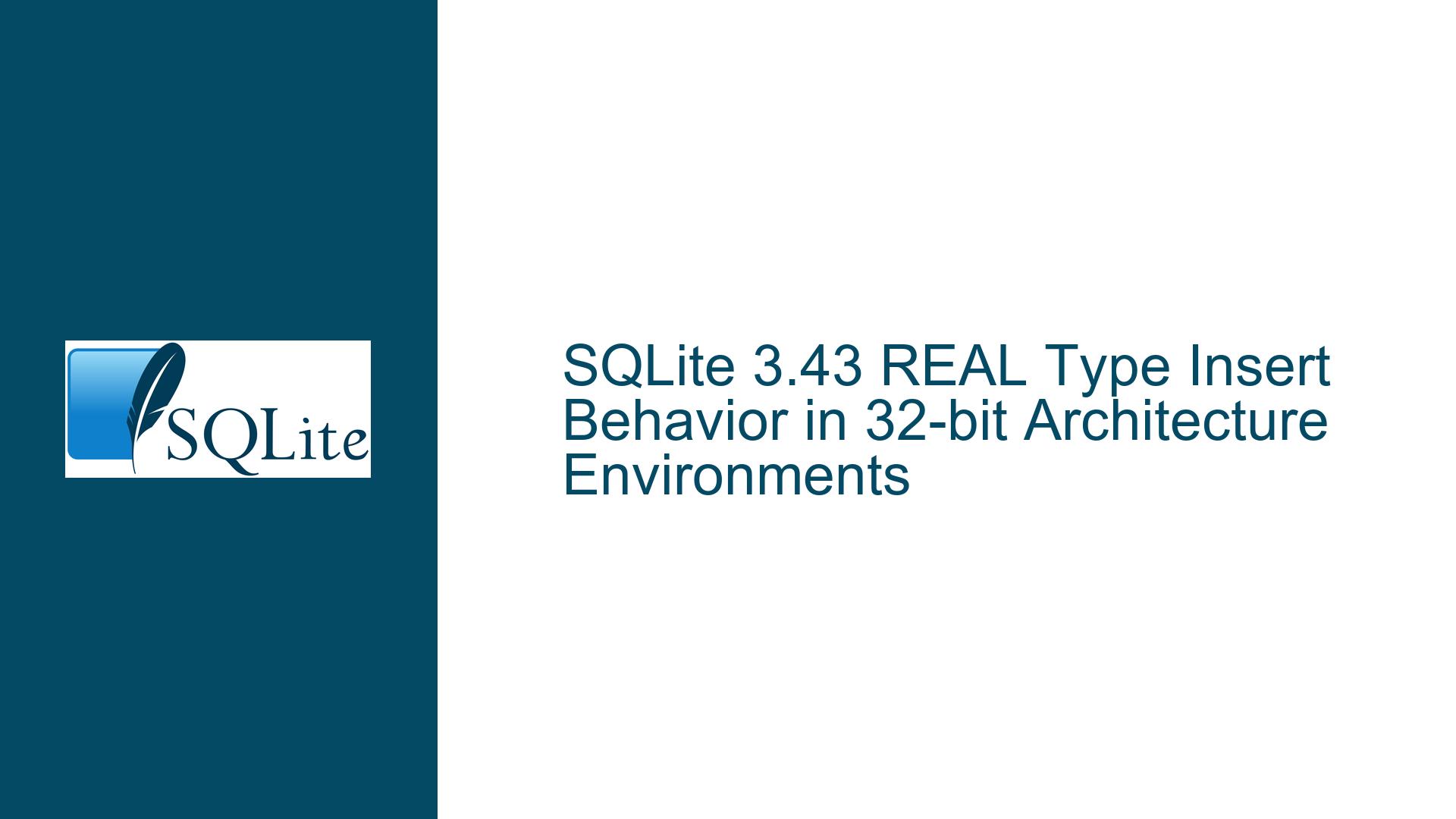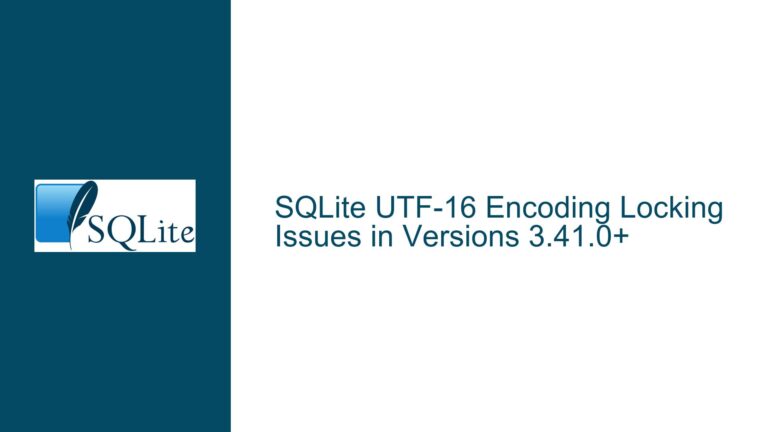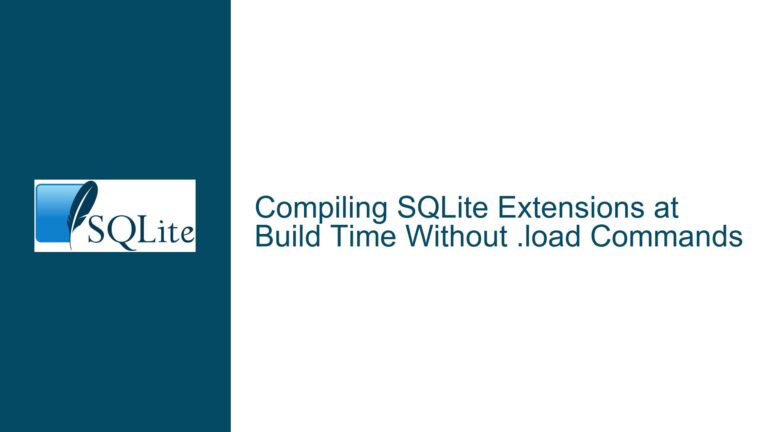SQLite 3.43 REAL Type Insert Behavior in 32-bit Architecture Environments
Floating Point Precision and Insert Behavior in SQLite 3.43
SQLite 3.43 introduced changes to the handling of floating-point numbers, particularly when inserting REAL type values in 32-bit architecture environments. These changes have led to unexpected behavior in certain scenarios, particularly when the floating-point unit (FPU) is configured to operate at a lower precision than the default. This issue manifests as a discrepancy in the least significant digit of the internal representation of floating-point numbers, causing values to differ slightly from what is expected. This behavior is most noticeable when inserting floating-point values directly as strings, as opposed to using prepared statements with bound parameters.
The core of the issue lies in how SQLite 3.43 handles the conversion of textual representations of floating-point numbers to their binary IEEE-754 representations. In previous versions of SQLite, the conversion logic was less sensitive to the precision settings of the FPU. However, in SQLite 3.43, the conversion algorithm was updated to be more consistent across platforms, which inadvertently exposed edge cases where the FPU’s precision settings affect the outcome. This is particularly problematic in environments where the FPU is configured to operate at 53-bit precision (double-precision) instead of the default 64-bit precision (extended-precision).
Impact of FPU Precision Settings on Floating-Point Conversions
The issue arises when the FPU’s precision is artificially reduced using platform-specific APIs or inline assembly instructions. For example, on x86 architectures, the FPU control word can be modified to change the precision of floating-point calculations. When the FPU is set to operate at 53-bit precision, SQLite 3.43’s conversion logic, which assumes 64-bit precision, produces slightly incorrect results. This is because the conversion algorithm relies on the sizeof(long double) test to determine the precision of the FPU. If the FPU is configured to operate at a lower precision, but sizeof(long double) still reports a size greater than 8 bytes, SQLite will use the faster, high-precision conversion algorithm, leading to inaccuracies.
This behavior is not limited to inline assembly. Similar results can be achieved using platform-specific APIs such as _controlfp_s on Windows, fpsetprec on FreeBSD, and _FPU_SETCW on Linux. These APIs allow applications to modify the FPU’s precision settings, which can inadvertently affect SQLite’s floating-point conversion logic. The issue is particularly pronounced in environments where the FPU’s precision is reduced for performance or compatibility reasons, as is sometimes the case in embedded systems or legacy applications.
Resolving Floating-Point Conversion Issues in SQLite 3.43
To address this issue, there are several approaches that can be taken, depending on the specific requirements of the application and the environment in which SQLite is being used. The first and most straightforward solution is to avoid modifying the FPU’s precision settings. If the FPU is left at its default precision, SQLite’s conversion logic will work as intended, and the issue will not occur. This is the recommended approach, as it ensures that SQLite’s assumptions about the FPU’s precision are correct.
If modifying the FPU’s precision settings is unavoidable, SQLite provides an unsupported interface that can be used to force the use of the slower, more accurate conversion algorithm. This can be done by calling sqlite3_test_control(SQLITE_TESTCTRL_USELONGDOUBLE, 0); before performing any floating-point conversions. This function tells SQLite to ignore the sizeof(long double) test and always use the binary-64 conversion algorithm, which is less sensitive to the FPU’s precision settings. However, this interface is not officially supported and may change in future versions of SQLite, so it should be used with caution.
For applications that require precise control over floating-point conversions, the best approach is to use prepared statements with bound parameters. When floating-point values are bound to a prepared statement, SQLite bypasses the textual conversion process entirely, ensuring that the exact binary representation of the value is preserved. This approach is not only more accurate but also more efficient, as it avoids the overhead of converting floating-point values to and from strings.
In summary, the issue with floating-point conversions in SQLite 3.43 is a result of changes to the conversion logic that make it more sensitive to the FPU’s precision settings. This issue can be avoided by leaving the FPU at its default precision or by using prepared statements with bound parameters. If modifying the FPU’s precision is necessary, the unsupported sqlite3_test_control interface can be used to force SQLite to use the binary-64 conversion algorithm, but this should be done with caution. By understanding the underlying causes of this issue and applying the appropriate solutions, developers can ensure that their applications continue to work correctly with SQLite 3.43 and beyond.






